An analysis into Kalafina's remastered All Time Best
A deep-dive into comparing the dynamic range and overall loudness of the remastered songs with the original CD recordings
This was originally posted on my Tumblr as a series of three articles, written as a response to this blog post and this reply about the remastered songs that make up the track listing for discs 1-3 of Kalafina’s All Time Best compilation album. Most of the songs originally appeared on their studio albums that were released between 2009 and 2015, and/or released as singles from 2008 to 2017. There was some discussion amongst the fan community about what differences there were, if any, between the “remastered” versions of the songs and the versions that were already on sale.
Introduction
As far as I’m aware from the production credits in the CD booklets, Kalafina’s albums and singles have always been mastered at the same place: the Sony Music Studios in Tokyo. The oldest and newest songs were recorded nine years apart, and the mastering engineer who worked on Seventh Heaven is different from the one who worked on Red Moon and everything else since then. Interestingly, that second engineer also mastered the All Time Best, so for everything except the first seven tracks it’s someone revisiting his/her earlier work! Some, or all, songs may still need to be tweaked to sound consistent with each other on this new track listing though, so they sound like they “belong” together on the new album. This is the most basic job of remastering, although other processes could have also been applied.
Of these, the most infamous and controversial mastering technique is “dynamic compression”. This involves making the quieter parts of a song louder in relation to the rest, giving the listener the impression that the song sounds louder overall. This may be helpful in listening environments where there’s a lot of background noise, such as on a car stereo or on a crowded bus or train, where the quieter moments of a song would be drowned out, and has been common practice in radio broadcasting for many years.
Most of the time though this isn’t preferable at all, because “dynamic range” is deliberately used by musicians to convey a contrasting mood or feel (a popular quote is: “if there is no ‘quiet’ there can be no ‘loud’”). The dynamic compression process can have unpleasant side-effects too, such as sounding indistinct and “mushy”: the satisfying “thump” of a bass drum for example becomes a weak “slap” that can’t be heard clearly over the other instruments. What’s worse, the mastering engineer can boost the overall volume so much that it’s distorted, which often sounds unpleasant and not very musical.
So, have the songs on this album been dynamically compressed in relation to their original versions? Quite honestly, I didn’t trust my ears enough with this so I used a dedicated piece of software to measure them. I ran the original and remastered versions of the songs through the software and compare the numbers side by side.
Methods
I copied the original albums from CD into flac (a lossless format) if I hadn’t already done so(1), then measured them with the Maat DROffline analysing software. All the songs were copied at the same bitrate as the industry standard for CD, so I’m fairly sure that the audio I measured was of the same quality as the CDs themselves.
This particular program uses its own scale for dynamic range, rounded to the nearest whole number: the higher the number, the bigger the range, and the less compressed and “processed” it is. When I tried this on a song that I’d recorded, which had not been subjected to any professional mastering procedure at all, the DR value was over 10! The dynamic range is also displayed to two decimal places separately for the left and right channels. The peak (the loudest moment in the track) and RMS (the “average” loudness throughout the track) are measured in decibels, stated as minus figures (the closer to zero they are, the louder they are). They too are displayed to two decimal places and shown separately for the left and right channels.
If a remastered song has been subjected to more dynamic compression than the older version, the DR value of the remastered song will be lower, even if the peak volume (the loudest moment on the track) is similar. Here’s an example of Oblivious and a song by another Japanese artist that’s stylistically very, very different:
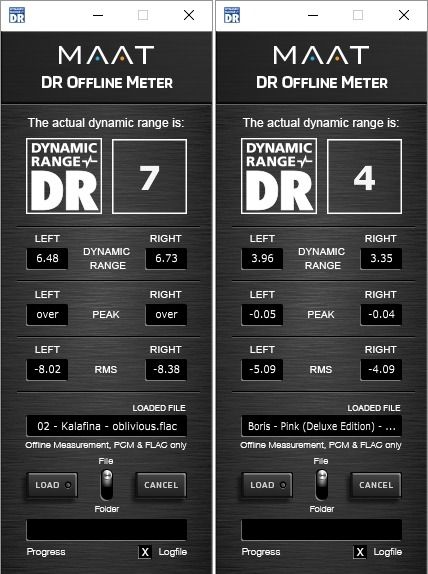
This is a side-by-side comparison of the original version of Oblivious next to Pink, a song by Boris that’s deliberately mixed and mastered to sound loud and lo-fi. At its loudest, Oblivious measures right at the maximum volume level and Pink is almost as loud, but the RMS (an “average” loudness over the entire song) of the Boris track is much higher. This explains the difference in the DR values: Pink *sounds* louder than Oblivious because it’s mixed to sound loud, distorted and fuzzy, even though the peak volumes are almost the same. Of course, no Kalafina song was every released to sound like that!
Results: Seventh Heaven
Here are the results side by side, original album version on the left and remastered on the right:
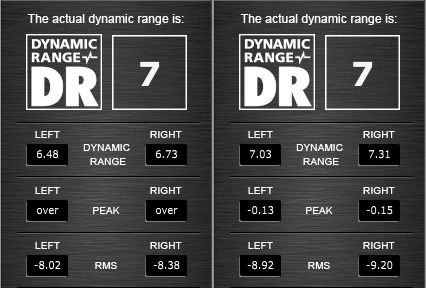
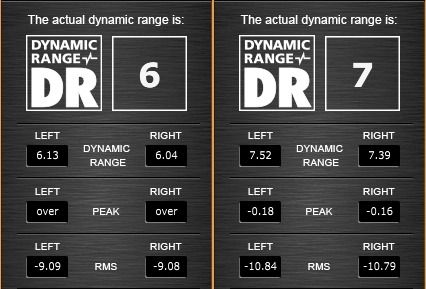
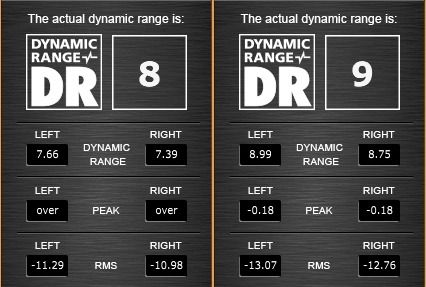
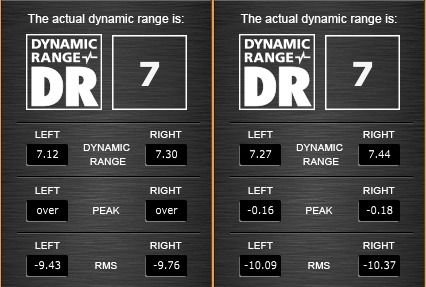
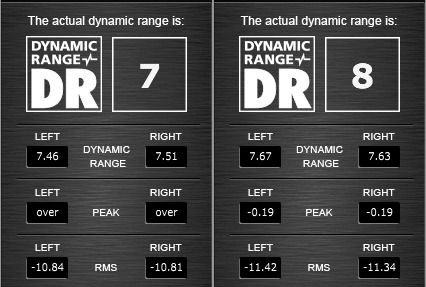
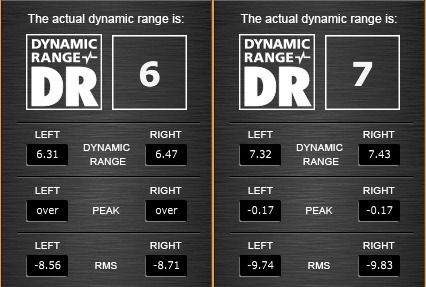
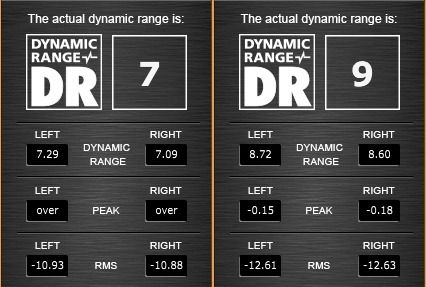
There is a measurable difference in terms of loudness between the two. The original songs hit a peak volume of zero(2); the remastered songs aren’t quite as loud, but the difference is minimal: no more than 0.2dB or so. It’s measurable, but I doubt that it’s noticeable at all.
The RMS, which is used by the software to calculate the dynamic range (DR) rating, was slightly lower in the remastered songs, so the DR is the same or slightly higher than before.
The waveforms look slightly different between the original and remaster though, as you can see from this segment of ARIA:

There’s slightly more dynamic compression going on in the original, but the important question is, “how do they sound?” When I listened to both at the same time, one through each headphone, I did think that the remastered Oblivious had more bass, especially in how powerful the kick drum was. Maybe you can hear a difference too; maybe not.
Are the remastered versions of the Seventh Heaven songs different? Technically, yes. Are they louder, more distorted and more compressed? Surprisingly, no. With normal everyday listening, I’m not sure whether you’d notice the difference. Even then, it’s a matter of personal taste as to which version you prefer. I personally don’t think the remastering has affected these particular songs for the worse. If anything, they’re an improvement…albeit a slight one.
Results: Red Moon onwards
For track #8 onwards in the remastered All Time Best, I didn’t check every single one. The main reason for this is, it might be long and tedious for you to read! I did however check songs at random in order to discern any trends, and I’ll summarise my findings here.
Peak output volume levels
Like Seventh Heaven, the peak output of each song from Red Moon, After Eden and Consolation is zero decibels. Even the singles that followed such as Alleluia (released between Consolation and Far on the Water) max out at zero. The remastered versions however all seem to peak at somewhere between -0.14 and -0.18, as the Seventh Heaven remasters do. As I said before: this isn’t a big difference, so they won’t sound noticeably quieter. It is interesting though that this is consistent across all the remastered tracks I checked, so it seems to have been a deliberate decision to make them similar in terms of loudness and to avoid mastering them at the theoretical “ceiling” of zero dB.
The flac versions of Far on the Water that I downloaded (I bought the vinyl edition but at the time couldn’t afford to import the CD as well!) measure similarly to the remastered CD: the title track for instance peaks at the same output volume on both. My best guess is that, sometime between Alleluia and Far on the Water, the engineer decided to (or was instructed to) master their songs a little quieter. Why? I’m not sure. In our post-“loudness war” era, peaking at zero decibels is less popular than it was, so perhaps it’s now considered “good practice” to give a song a bit of headroom?
Dynamic range
The DR readings for the songs on the original versions of Red Moon and After Eden vary but some of them are, surprisingly, really rather low. Lacrimosa and Progressive for instance measure just 5, which is even lower than anything on Seventh Heaven that I measured! The remasters are more consistent: again, between 7 and 9, depending on the song. This is a definite improvement, but what shocked me is how compressed the original albums are! They were released in the late 2000s and early 2010s though, which was in the same decade as the likes of Black Holes and Revelations by Muse and Death Magnetic by Metallica: an era when commercially popular rock and pop albums were notorious for compressed “loudness war” mastering. I’d say that Kalafina’s first few records are unfortunately products of their time, and were produced using the industry practices that were in fashion back then for chart music. Here’s Lacrimosa:
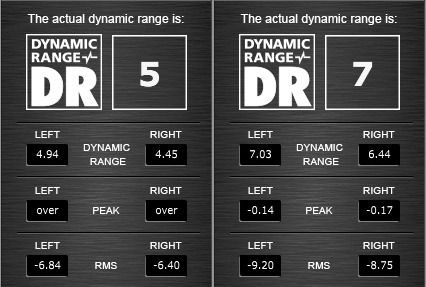
Interestingly, Far on the Water and their last few singles generally measure around the same as the remasters, so reducing the DR wasn’t a decision made specially for the All Time Best: it was done way back when Far on the Water was released. Here’s the comparison for the title track:
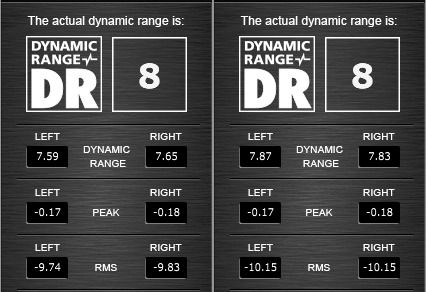
The peak levels are the same but there are *some* differences to the RMS (average level), albeit not enough to affect the DR rating. The remastering IS different, but not by much.
Conclusions
In terms of output volume, the remasters are either slightly, but probably not noticeably, quieter (Red Moon to Consolation) or about the same (Far on the Water onwards). Similarly, there are either increases or no change at all in the dynamic range: it is either increased (Red Moon to Consolation) or about the same (Far on the Water onwards). Remastered music is often associated with increased loudness and/or more compressed dynamics, but it’s apparently not the case here. In terms of *these specific aspects*, I have to say that a pretty good job was done on the All Time Best to make the songs’ volume levels and dynamics as good as, or better than, the versions that are already available.
Other stuff
Of course, there’s more to remastering than just adjusting the output levels and amount of compression. Equalisation could be altered, and other effects like reverb and stereo widening could have been applied. I can’t look into those right now, because I don’t have the tools to objectively measure them. I know that some people reported hearing changes to some tracks, but I’m not going to argue against that.
Does the remastered Lacrimosa for instance sound better? The issue is, unless there’s a way of objectively measuring something, it depends on your own equipment and your own ears: there’s no definitive right or wrong answer, and the important thing is that you still enjoy what you’re hearing. For example, I thought that Oblivious sounds slightly clearer and bass-y than before, which to me is an improvement. Even on vinyl, Blaze sounds pretty bad to me because the vocals sound too loud in relation to the rest of the instruments(3). Others might disagree, and I’m totally okay with that.
There’s also a lot of snobbery among music fans. If you’re listening to your Kalafina collection on a pair of ordinary earbuds in mp3 and it sounds fine to you, that’s good enough.
I ought to reiterate that I’m just an enthusiastic amateur teaching myself music recording and production, and I have no professional musical experience or training at all. Thank you for reading to the end!
Footnotes
1. Most of my music collection is copied from CD and backed up on my hard drive in flac format. This is done for convenience’s sake more than anything else: I can listen to all of it in Winamp on my PC or copy it onto my Walkman while the CDs stay safe on my shelf. My vinyl collection is the exception, but sometimes download cards are included so you can own both a record and a digital copy of the songs. This isn’t the case for Kalafina’s vinyl releases, but many US and European bands do this
2. I was a bit confused about the peak loudness being displayed as “over” rather than an actual number, so I went a bit further and opened Oblivious and ARIA in Cubase (you could try this with any audio editing software; Audacity could work too, and it’s free!). The original version of Oblivious does indeed hit 0 decibels, so I think DROffline reports zero as “over” by default
3. I suspect that the problem I have with Blaze is with the mixing of the vocals and other instruments, which is a separate thing from the mastering (which is done after mixing is complete and is concerned with the track as a whole). While this article demonstrates that there are differences in mastering, I've not found any evidence so far that the mixes were altered at all
